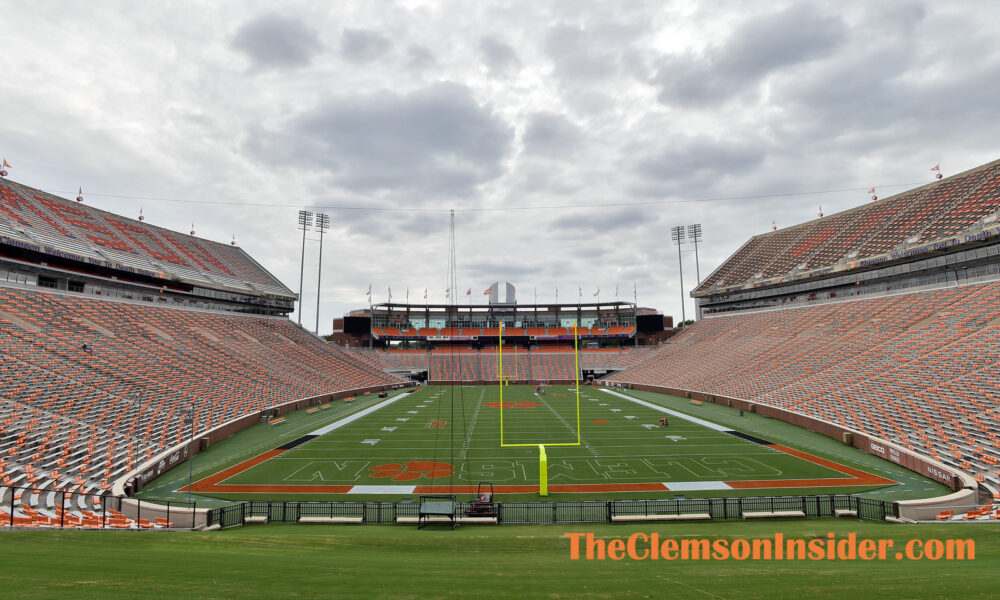When Jess Neely left Clemson for Rice in 1940, he left the job to Frank Howard, who accompanied him to Clemson from Alabama in 1931. Neely thought a lot of Howard, and he wanted to see him succeed as a head coach. Neely gave Howard one piece of advice before heading to Houston.
“Don’t ever let them talk you into building a big stadium,” Neely said to Howard. “Put about 10,000 seats behind the YMCA. That’s all you’ll ever need.”
As we all know, Howard did not listen to Neely’s advice. Soon after Neely left, Howard began drawing up plans for a 20,000-seat stadium located in a natural Valley a little west of Historic Riggs Field, now the soccer stadium at Clemson. By the end of the 1940 season, trees were already being cleared in the valley. Howard was right there, cutting them down and clearing the path.
In fact, much of the building of the football stadium was built by scholarship athletes, including football players. The first staking out of the stadium was done by A.N. Cameron and Hugh Webb, who returned to Clemson years later to be an architecture professor.
However, this new stadium was not built without a few problems. One player told Howard during the clearing of the land that he was not allergic to poison oak. So, as the story goes, Howard put him to work slinging down all the poison oak, which of course he threw all over him. The next day, the player was swollen twice his size and was hospitalized.
When the concreate was later poured, Howard, known for chewing his tobacco, placed a little bit of chew in each corner of the stadium, permanently leaving a part of him in the stadium he built.
Howard said the seeding of the grass was the biggest issue. They had about 40 people laying the sod. About three weeks into the project, they had gotten just about halfway through.
“I told them it had taken us three weeks to get that far and I would give them three more weeks’ pay for however long it took to finish,” Howard said. “I also told them we would have 50 gallons of ice cream when we got through.
“After that, it took them about three days to do the rest of the field. Then we sat down in the middle of the field and ate up that whole 50 gallons.”
Memorial Stadium, named in honor of the former Clemson students and alumni who sacrificed their lives in the great World Wars, opened its gates for the first time on September 19, 1942 … exactly 78 years to the day on Saturday when the Tigers host The Citadel for a 4 p.m. kick.
“The gates were hung at 1 p.m., and we played at 2 p.m.,” Howard later said.
Never has a season opener resembled what it might have been like in 1942 than Saturday’s season-opener. Though Death Valley has since expanded to 81,500, because of the COVID-19 pandemic, Clemson had to prep Memorial Stadium to accommodate just 19,000 fans this year, while also sanitizing the facility and getting it socially distant ready to combat against the spread of the virus.
The end result is Saturday’s game will be played in front of a comparable capacity to the stadium’s 1942 configuration.
Neely thought Howard was nuts for building a new stadium in 1942. He felt all the program needed was at Riggs Field, which sat about 9,000 fans at the time. During Neely’s tenure, the Tigers did not have very many home games. Clemson never played more than four games in any season during his nine years in Clemson, and it only did that one time.
In six of his seasons, the Tigers played only two home games. It is easy to see why Neely figured Clemson did not need a big stadium.
But Howard, 31 years old at the time, was a visionary and he always looked towards the future. He knew something good was brewing at Clemson. He saw the passion in the fan base and how much they loved their Clemson football.
Clemson beat Presbyterian, 32-13, in front of an estimated crowd of 5,000 fans in that first game
“The way I see it, Memorial Stadium his Coach Howard. He designed it. He cut down the trees. He poured the concrete and he laid down the grass. He about did it all,” said former head coach Danny Ford.
Though Howard built Memorial Stadium, he is not the person responsible for its’ nickname. And, just in case an LSU fan is reading this, Tiger Stadium in Baton Rouge, Louisiana is not college football’s real Death Valley. That distinction belongs to Clemson.
Cally Gault remembers his first trip to Clemson quite well. A freshman at Presbyterian at the time, he and his Blue Hose teammates came to Clemson and were thrashed, 76-0.
The Tigers netted 516 yards on the ground as 14 different players carried the ball on September 22, 1945. Clemson freshman Bobby Gage, who went on to play for the Pittsburgh Steelers, led the Tigers with 144 yards, including an 88-yard touchdown run. All 11 of Clemson’s touchdowns came on the ground that afternoon, which is a record that still stands today.
Soon after being beat so bad by the Tigers, Presbyterian head coach Lonnie McMillian gave Memorial Stadium a nickname.
“After we were beaten so badly in 1945, Coach McMillian and us players referred to the Clemson trip as going ‘to Death Valley,’” said Gault. “I’m not sure when the press picked up on it, but I’m sure it was real soon.”
The press picked up on it because McMillian would tell them, “I’m taking my boys to Death Valley,” when he spoke about the Clemson trip. Presbyterian and Clemson opened the season every year from 1930-1957.
Gault was a player and coach during most of those years and none of the PC teams he was on came close to beating Clemson, which became relevant on the national scene in the late 1930s and early 1940s.
“I was 16 years old as a freshman when I came to PC, and playing in Death Valley was special,” said Gault, who was also the head coach at Presbyterian from 1962-’84. “I do remember this more than anything – it was hot, and I mean real hot at Clemson. You haven’t felt hot until you played in Death Valley in early September.”
Howard soon picked up on the moniker “Death Valley” and started referring to Memorial Stadium as such when he went to IPTAY meetings or when speaking to the press. The earliest accounts of Howard using the nickname came in the late 1940s and early ’50s when the Tigers were making regular trips to bowl games like the Gator Bowl, the Orange Bowl and the Sugar Bowl.
“When Coach Howard picked up on the nickname and started using it to the media, it became really popular,” Gault said.
Through the years, Death Valley has lived up to its nickname. The Tigers have totaled 316 wins in the previous 77 years and have won nearly 75 percent of its games (316-102-7). It’s the only place Heisman Trophy winner, and Georgia running back, Herschel Walker lost a regular season game in his three years at Georgia.
Led by All-American linebacker Jeff Davis and All-American safety Terry Kinard, the Tigers took down the Bulldogs, 13-3, on September 19, 1981. The Tigers forced a record nine Georgia turnovers that day.
“I came here knowing it would be loud and Clemson would hit hard, but the noise was the biggest factor. I didn’t concentrate as well because of it,” Walker said afterward.
Under Dabo Swinney, Death Valley has never been so good. The Tigers are 71-6 under Swinney, including a 60-3 home record from 2011-2018. Clemson had a 21-game home winning streak from 2013-2016 and enters this season with a 22-game home winning streak.
The Tigers were 43-1 at Death Valley since the middle of the 2013 season.
“It is one of the best places to play in college football,” Texas A&M head coach Jimbo Fisher said prior to his team’s 2019 trip to Clemson. “It is Death Valley. It will be loud.”
Through the years Memorial Stadium has grown and changed its appearance. In 1958, 18,000 seats were added and in 1960, 5,658 seats were built in the west end zone due to an increase in ticket demands.
With the west end zone stands, capacity increased to 53,000. It stayed that way until 1978 when Clemson added an upper deck on the south side of the stadium. In 1983, an upper deck was added on the north side, swelling the capacity to more than 80,000.
Over the years, Memorial Stadium has packed in more than 86,000 diehard Clemson fans.
“There will be a lot of orange. If you like orange, there will be a lot of that,” said Fisher, who is 1-4 at Death Valley. “There will be a lot of happy fans. They are a great fan base. Tremendous fans base, a classy fan base. But very loud and hard to go play in.
“Like in [the SEC], it is like the venues you are going to play in, in our league. It is 80,000 something or 90,000 or whatever it is. They love their ball and they are passionate about it, that is for sure.”
Today, Memorial Stadium is one of the largest on campus stadiums in the country, with crowds over the 81,500 capacity.
“We go to a lot of great venues for college football, but this doesn’t take a back seat to any place. In terms of the atmosphere, stadium, noise and facilities, this is a special place on a Saturday night,” ESPN analyst Todd Blackledge said.
It is a good thing Frank Howard did not listen to Jesse Neely all those years ago.
A great gift for any Tiger fan. Just one of many great items available from Clemson Variety & Frame

